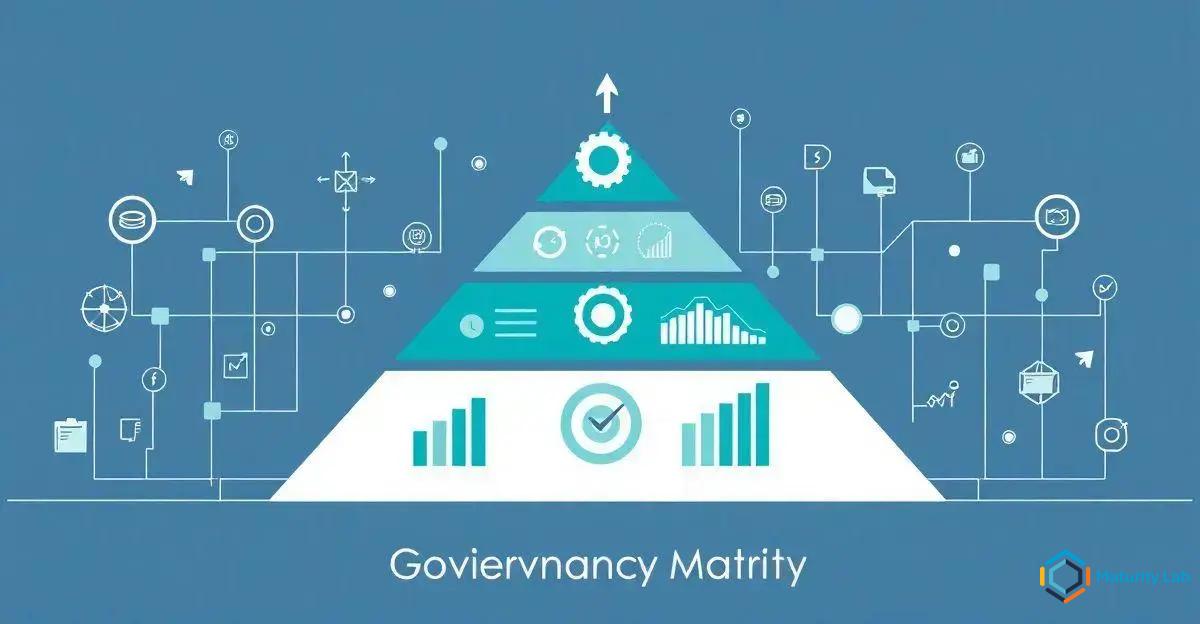Governance Maturity Models (GMMs) and performance indicators (KPIs) are vital tools for improving organizational governance. GMMs offer structured frameworks for assessing and enhancing governance practices, enabling organizations to benchmark against industry standards and set achievable goals. KPIs provide measurable values to track governance efficiency and effectiveness. The implementation of KPIs involves identifying key governance areas, establishing baselines, integrating them into the governance framework, and ongoing monitoring. Together, GMMs and KPIs facilitate better decision-making, strategic alignment, and overall performance enhancement.
In today’s dynamic business environment, understanding and implementing a Governance Maturity Model is crucial for ensuring robust governance and effective monitoring. By leveraging key performance indicators, organizations can enhance their governance frameworks, leading to improved decision-making and strategic alignment. This article delves into the intricacies of Governance Maturity Models, exploring their significance and the role of performance indicators in governance monitoring. Whether you are familiar with PEMM, BPMM, CMMI, or other models, this guide will provide valuable insights to elevate your organization’s governance practices.
Understanding Governance Maturity Models

Governance Maturity Models (GMMs) serve as frameworks that help organizations assess and enhance their governance practices.
These models provide a structured approach to evaluating the current state of governance and identifying areas for improvement. By understanding where an organization stands on the maturity spectrum, leaders can make informed decisions to elevate their governance structures.
One of the primary benefits of using a GMM is the ability to benchmark against industry standards. Models such as the Process and Enterprise Maturity Model (PEMM), Business Process Maturity Model (BPMM), and Capability Maturity Model Integration (CMMI) offer detailed criteria that organizations can use to measure their governance maturity. These benchmarks help organizations understand their relative position and set realistic goals for advancement.
A key component of GMMs is the identification of maturity levels.
Typically, these levels range from initial or ad-hoc stages to optimized or advanced stages. For example, the CMMI model categorizes maturity into five levels: Initial, Managed, Defined, Quantitatively Managed, and Optimizing. Each level represents a progression in governance capabilities, from basic compliance to continuous improvement and innovation.
Implementing a GMM involves several steps. First, organizations must conduct a thorough assessment of their current governance practices. This assessment often includes surveys, interviews, and document reviews to gather comprehensive data. Next, the data is analyzed to identify gaps and areas for improvement. Based on this analysis, organizations can develop a roadmap for enhancing their governance maturity, outlining specific actions and milestones.
Furthermore, GMMs emphasize the importance of continuous monitoring and evaluation. Governance is not a one-time effort but an ongoing process that requires regular review and adjustment. By establishing key performance indicators (KPIs) and monitoring them consistently, organizations can track their progress and make necessary adjustments to stay on course.
In conclusion, Governance Maturity Models are essential tools for organizations aiming to strengthen their governance frameworks. By providing a clear path for assessment and improvement, these models enable organizations to achieve higher levels of governance maturity, ultimately leading to better decision-making, strategic alignment, and overall performance.
Implementing Performance Indicators for Effective Governance Monitoring

Implementing performance indicators is a critical aspect of effective governance monitoring.
Performance indicators, often referred to as Key Performance Indicators (KPIs), provide measurable values that help organizations track the efficiency and effectiveness of their governance practices.
By establishing relevant KPIs, organizations can gain insights into their governance processes and make data-driven decisions to enhance performance.
The first step in implementing performance indicators is to identify the key areas of governance that need monitoring.
These areas may include compliance, risk management, strategic alignment, and stakeholder engagement.
Each area should have specific KPIs that reflect the organization’s governance objectives.
For instance, in the area of compliance, a KPI might be the percentage of internal audits completed on time.
In risk management, a KPI could be the number of identified risks mitigated within a specified period.
Once the KPIs are identified, it is essential to establish baseline measurements.
Baseline measurements provide a starting point against which future performance can be compared.
This involves collecting historical data and conducting initial assessments to determine the current state of governance.
With baseline measurements in place, organizations can set realistic targets and benchmarks for each KPI.
The next step is to integrate the KPIs into the organization’s governance framework.
This involves aligning the KPIs with the organization’s strategic goals and ensuring that they are communicated effectively across all levels of the organization.
It is crucial to involve key stakeholders in this process to ensure buy-in and commitment.
Additionally, organizations should leverage technology to automate the collection and reporting of KPI data.
Tools such as governance, risk, and compliance (GRC) software can streamline this process and provide real-time insights.
Regular monitoring and review of KPIs are vital to ensure their effectiveness.
Organizations should establish a governance committee or task force responsible for overseeing the monitoring process.
This committee should conduct periodic reviews of KPI performance, identify trends, and make recommendations for improvement.
By continuously evaluating the KPIs, organizations can adapt to changing circumstances and maintain the relevance of their governance monitoring efforts.
Moreover, it is important to foster a culture of accountability and continuous improvement.
Organizations should encourage employees to take ownership of their roles in governance and provide training and resources to support their efforts.
By promoting a proactive approach to governance, organizations can ensure that performance indicators are not just metrics but tools for driving meaningful change.
In summary, implementing performance indicators for effective governance monitoring involves identifying key governance areas, establishing baseline measurements, integrating KPIs into the governance framework, and continuously monitoring and reviewing performance.
By following these steps, organizations can enhance their governance practices, achieve strategic objectives, and ultimately improve overall performance.
In conclusion, the adoption of Governance Maturity Models and the implementation of performance indicators are pivotal for organizations striving to enhance their governance frameworks.
Governance Maturity Models provide a structured approach to evaluating and improving governance practices, enabling organizations to benchmark against industry standards and set realistic goals for advancement.
By identifying maturity levels and conducting thorough assessments, organizations can develop actionable roadmaps for continuous improvement.
Performance indicators, on the other hand, offer measurable values that facilitate effective governance monitoring.
By identifying key governance areas, establishing baseline measurements, and integrating KPIs into the governance framework, organizations can track their progress and make data-driven decisions.
Regular monitoring and review of KPIs ensure that governance practices remain relevant and effective, fostering a culture of accountability and continuous improvement.
Ultimately, the combination of Governance Maturity Models and performance indicators empowers organizations to achieve higher levels of governance maturity.
This leads to better decision-making, strategic alignment, and overall performance.
As organizations navigate the complexities of today’s business environment, these tools provide the clarity and direction needed to build robust governance structures and achieve long-term success.
Frequently Asked Questions about Governance Maturity Models and Performance Indicators
What is a Governance Maturity Model?
A Governance Maturity Model (GMM) is a framework that helps organizations assess and enhance their governance practices by providing a structured approach to evaluating the current state of governance and identifying areas for improvement.
Why are Governance Maturity Models important?
Governance Maturity Models are important because they enable organizations to benchmark against industry standards, identify maturity levels, and develop actionable roadmaps for continuous improvement, ultimately leading to better decision-making and strategic alignment.
What are Key Performance Indicators (KPIs) in governance?
Key Performance Indicators (KPIs) in governance are measurable values that help organizations track the efficiency and effectiveness of their governance practices. They provide insights into governance processes and support data-driven decision-making.
How do you implement performance indicators for governance monitoring?
Implementing performance indicators involves identifying key governance areas, establishing baseline measurements, integrating KPIs into the governance framework, and continuously monitoring and reviewing performance to ensure their effectiveness.
What are some examples of governance KPIs?
Examples of governance KPIs include the percentage of internal audits completed on time, the number of identified risks mitigated within a specified period, and the level of stakeholder engagement in governance processes.
How can organizations ensure continuous improvement in governance?
Organizations can ensure continuous improvement in governance by fostering a culture of accountability, regularly monitoring and reviewing KPIs, involving key stakeholders, and providing training and resources to support governance efforts.

